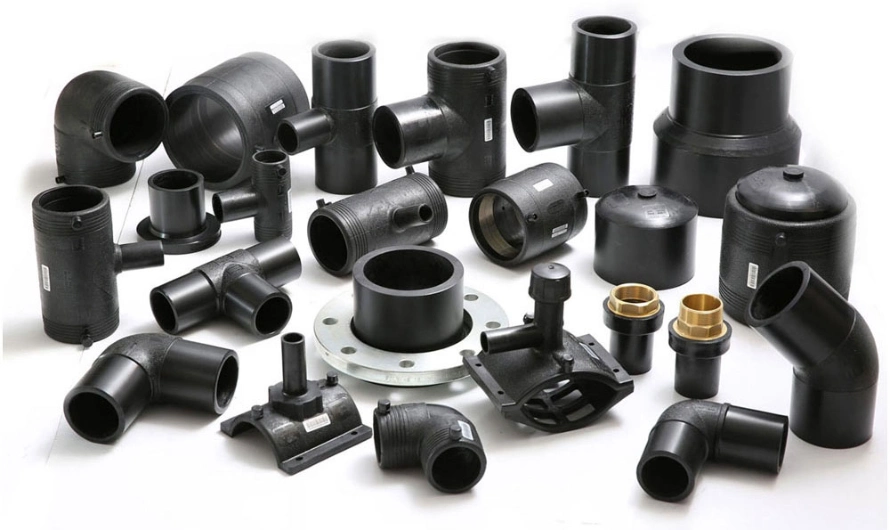High-Density Polyethylene (HDPE) pipe systems have become the backbone of modern infrastructure projects, thanks to their durability, flexibility, and cost-effectiveness. A crucial component of these systems is the HDPE butt fusion fittings, which ensure a seamless and robust connection between pipes. Leading brands like JS PIPE offer high-quality HDPE fittings that meet the demands of various industries. This article explores the construction, advantages, and diverse applications of HDPE butt fusion fittings in HDPE pipe systems.
Construction of HDPE Butt Fusion Fittings
HDPE butt fusion fittings are designed to connect HDPE pipes through a fusion process that involves heating and joining the pipe ends. The construction of these fittings involves several key steps:
- High-Quality HDPE Material: HDPE fittings are made from high-grade HDPE resin, known for its excellent strength-to-density ratio. This ensures that the fittings can withstand high pressures and harsh environmental conditions.
- Precision Molding: The fittings are produced using precision molding techniques to ensure accurate dimensions and a perfect fit. This process includes heating the HDPE material and shaping it into the desired fitting design.
- Fusion Compatibility: Each fitting is designed to be compatible with the butt fusion process. This involves creating smooth, flat surfaces that can be easily heated and fused together with HDPE pipes.
- Quality Control: Rigorous quality control measures are in place to test the fittings for various parameters such as pressure resistance, dimensional accuracy, and long-term durability. Only fittings that pass these stringent tests are marketed.
JS PIPE, a leading brand in the HDPE pipe industry, employs advanced manufacturing techniques and strict quality control measures to produce top-notch HDPE butt fusion fittings. For more details on their product specifications and quality standards, read more about JS PIPE’s offerings.
Advantages of HDPE Butt Fusion Fittings
The use of HDPE butt fusion fittings in HDPE pipe systems offers numerous benefits:
- Seamless Connections: The butt fusion process creates a seamless and monolithic connection between pipes and fittings. This eliminates the risk of leaks and ensures a strong, durable bond.
- Corrosion Resistance: HDPE fittings are highly resistant to corrosion, making them ideal for use in harsh environments where traditional metal fittings would degrade over time.
- High Durability: These fittings can withstand high pressure and extreme temperatures, ensuring long-term performance and reliability in various applications.
- Cost-Effectiveness: The longevity and low maintenance requirements of HDPE fittings make them a cost-effective choice for infrastructure projects. They reduce the need for frequent replacements and repairs.
- Flexibility: HDPE fittings are flexible and can accommodate ground movements and temperature changes without cracking or breaking. This makes them suitable for a wide range of applications, including those in seismic zones.
- Environmental Sustainability: HDPE is a recyclable material, and the use of HDPE fittings contributes to sustainable construction practices. Additionally, the butt fusion process minimizes waste and energy consumption.
Applications of HDPE Butt Fusion Fittings in HDPE Pipe Systems
HDPE butt fusion fittings are used in a wide array of applications due to their versatility and reliability:
- Water Supply Systems: These fittings are commonly used in municipal water supply networks to ensure a reliable and leak-free distribution of potable water.
- Gas Distribution: HDPE fittings are ideal for gas pipelines, offering a safe and durable solution for transporting natural gas and other gases.
- Sewage and Drainage Systems: In sewage and drainage systems, HDPE fittings provide robust connections that can handle the corrosive nature of wastewater and effluents.
- Industrial Applications: Various industries use HDPE pipe systems for transporting chemicals, slurries, and other industrial fluids. The corrosion resistance of HDPE fittings makes them suitable for such applications.
- Agricultural Irrigation: HDPE fittings are widely used in agricultural irrigation systems, ensuring efficient and leak-free distribution of water to crops.
- Mining: In the mining industry, HDPE fittings are used for slurry transportation and tailings pipelines, where their durability and resistance to abrasion are essential.
- Geothermal Systems: HDPE fittings are used in geothermal heating and cooling systems, providing reliable connections that can withstand the thermal stresses associated with such applications.
JS PIPE’s HDPE fittings are engineered to meet the diverse needs of these applications, offering reliable and efficient solutions for modern infrastructure projects. To explore the full range of products and understand how JS PIPE can enhance your piping systems, read more about their offerings.
In conclusion, HDPE butt fusion fittings play a crucial role in ensuring the integrity and performance of HDPE pipe systems. With their superior construction and numerous advantages, HDPE fittings from JS PIPE are an excellent choice for a wide array of applications, delivering reliability, durability, and cost-effectiveness.
Keep an eye for more news & updates on TimesAnalysis.com



